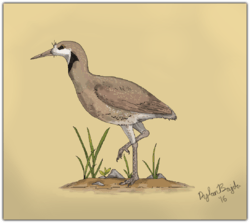Proapteryx
| Proapteryx Temporal range: early Miocene 19–15 Ma | |
|---|---|
 | |
| Life restoration. | |
| Scientific classification | |
| Kingdom: | Animalia |
| Phylum: | Chordata |
| Class: | Aves |
| Subclass: | Carinatae |
| Infraclass: | Neornithes |
| Superorder: | Paleognathae |
| Order: | Apterygiformes |
| Genus: | †Proapteryx Worthy et al. 2013[1] |
| Species | |
|
†Proapteryx micromeros Worthy et al. 2013 | |
Proapteryx micromeros is an extinct kiwi known from the early Miocene sediments of the Saint Bathans Fauna of Otago, New Zealand.[2][1]
Features
P. micromeros is considerably smaller than modern kiwis, weighing around 234.1 – 377g (the smallest living kiwi, Apteryx owenii, weighs at least 800 g), and its more gracile otic process may indicate a shorter bill. It bears distinctively slender hindlimbs, more comparable in terms of proportion to flying birds like the banded rail than to extant kiwis, and it is speculated to have been capable of powered flight, or to have evolved relatively recently from flying ancestors.
Importance
The fact that Proapteryx lacked specialisation for a terrestrial, flightless lifestyle supports the hypothesis that kiwi ancestors flew to New Zealand from Australia in the Miocene, well after moas had developed into their modern forms (moa remains are also known from Saint Bathans, already large and flightless[3][4]), confirming genetic and morphological analysis that showcase that the two clades arrived to New Zealand independently, and that they are not particularly closely related; moas forming a clade with tinamous and kiwis with Australian ratites, the cassowary and emu.[5][6]
Kiwis have also been understood as the sister taxa of elephant birds, and Proapteryx establishes the existence of flying Australian palaeognaths as recently as the early Miocene, indicating that the Malagasy ratites may have flown across the Indian Ocean around this time period.[7]
References
- 1 2 Worthy, Trevor H.; et al. (2013). Miocene fossils show that kiwi (Apteryx, Apterygidae) are probably not phyletic dwarves (PDF). Paleornithological Research 2013, Proceedings of the 8th International Meeting of the Society of Avian Paleontology and Evolution. Retrieved 9 March 2014.
- ↑ Egan, Joanna (15 January 2014). "NZ kiwi made in Australia?". Australian Geographic. Retrieved 2015-02-27.
- ↑ Worthy, T.H., Tennyson, A.J.D., Jones, C., McNamara, J.A. & Douglas B.J. (2007): Miocene waterfowl and other birds from Central Otago, New Zealand. Journal of Systematic Palaeontology, 5: 1–39.
- ↑ Tennyson, A.J.D., Worthy, T.H., Jones, C.M., Scofield, R.P. & Hand, S.J. (2010). Moa’s Ark: Miocene fossils reveal the great antiquity of moa (Aves: Dinornithiformes) in Zealandia. Records of the Australian Museum, 62: 105–114.
- ↑ "Kiwi may be Australian export". ABC Science. Australian Broadcasting Corporation. 9 February 2001. Retrieved 2015-02-27.
- ↑ Phillips, M.J., Gibb, G.C., Crimp, E.A. & Penny, D. (2010). Tinamous and moa flock together: mitochondrial genome sequence analysis reveals independent losses of flight among ratites. Systematic Biology, 59: 90–107.
- ↑ Mitchell, Kieren J.; et al. 2014. "Ancient DNA reveals elephant birds and kiwi are sister taxa and clarifies ratite bird evolution". Science, vol. 344, no. 6186, pp. 898-900; doi: 10.1126/science.1251981